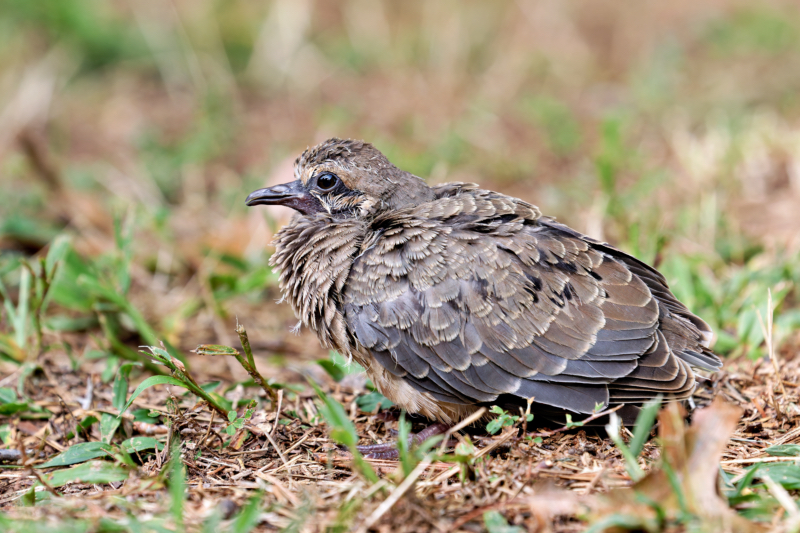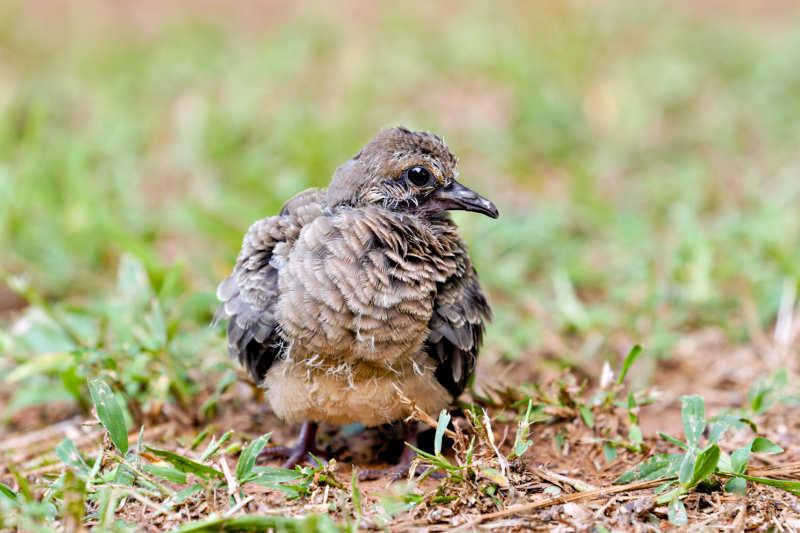In August 2017, I had a rare and exciting encounter in my backyard, a Mourning Dove fledgling. Despite these birds nesting in my yard every year, it’s not often that I spot their young ones. This experience got me thinking about why these charming little creatures seem to be so elusive.

Mourning Dove fledglings, also known as squabs, are truly remarkable in their rapid growth and development. Born tiny and helpless, they double in size almost daily, reaching the point of leaving the nest in just about two weeks. This astounding rate of growth might be one reason why we don’t see them often – blink, and you might miss their brief childhood!

The parental care of Mourning Doves is equally fascinating. Both parents share the responsibilities of incubation and feeding. In the first few days of life, the fledglings are nourished with “crop milk,” a nutrient-rich substance secreted by both parents. This special diet is crucial for their rapid growth and developing immune system.
After fledging, these young birds enter a critical period of learning and development. They often hide under vegetation for a couple of days while their parents continue to feed them. During this time, they’re acquiring essential survival skills and working towards independence. It’s interesting to note that fledglings are well-feathered and mobile but may not be strong flyers initially, preferring to walk rather than fly.
One distinctive feature of Mourning Dove fledglings is their disproportionately large eyes. This characteristic gives them a unique, almost comical appearance that sets them apart from their adult counterparts.
The adaptability of Mourning Doves is truly impressive. From urban landscapes to desert environments, these birds and their offspring can thrive in a wide range of habitats. This adaptability, combined with the dedicated care of their parents, contributes significantly to their success as a species across North America.
My brief encounter with that fledgling in 2017 opened my eyes to the hidden world of these remarkable birds. While we may not see them often, Mourning Dove fledglings are out there, growing rapidly and preparing for their adult lives under the watchful eyes of their devoted parents. Next time you’re in your yard, take a moment to look closely, you might just spot one of these fascinating young birds on their journey to adulthood.

Fascinating. I live across the way of a property that housed mourning dove. The former owner equipped three shipping containers and raised them. Needless to say, they are still here, and I feed them. Constantly. Huge!
Steve,
Your photographs and explanation of Dove behavior are enjoyable and interesting. Earlier this summer I thought I was watching a pair of mature Doves sitting on a fence in my backyard and wondered why they didn’t scatter when my two year Lapponian Herder tried to chase them. A closer look revealed they were young and either couldn’t fly well or hadn’t learned to move out of harms way. The youngsters and my pup were having an amusing standoff. I also had the pleasure of watching one of the parents feeding the Doves. Thanks for sharing.
I have never gotten a photo of the young being fed. Maybe one of these days. I’m glad you enjoyed this blog post. Thank you!